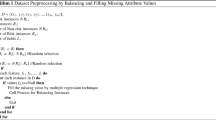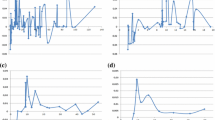Abstract
The wrong clusters number or poor starting points of each cluster have negative influence on the classification accuracy in the hybrid classifier based credit scoring system. The paper represents a new hybrid classifier based on fuzzy-rough instance selection, which have the same ability as clustering algorithms, but it can eliminate isolated and inconsistent instances without the need of determining clusters number and starting points of each cluster. The unrepresentative instances that cause conflicts with other instances are completely determined by the fuzzy-rough positive region which is only related to intrinsic data structure of datasets. By removing unrepresentative instances, both the training data quality and classifier training time can be improved. To prevent eliminating more instances than strictly necessary, the k-nearest neighbor algorithm is adopted to check the eliminated instances, and the instance whose predicted class is the same with predefined class is added back. SVM classifier with three different kernel functions are applied to the reduced dataset. The experimental results show that the proposed hybrid classifier has better classification accuracy on two real world datasets.




Similar content being viewed by others
References
Gao ZK, Yang YX, Fang PC, Zou Y, Xia CY, Du M (2015) Multiscale complex network for analyzing experimental multivariate time series. Europhys Lett 109:30005
Gao ZK, Cai Q, Yang YX, Dong N, Zhang SS (2017) Visibility graph from adaptive optimal Kernel time–frequency representation for classification of epileptiform EEG. Int J Neural Syst 27(4):1750005
Gao ZK, Small M, Kurths J (2016) Complex network analysis of time series. Europhys Lett 116:50001
Gao ZK, Cai Q, Yang YX, Dang WD, Zhang SS (2016) Multiscale limited penetrable horizontal visibility graph for analyzing nonlinear time series. Sci Rep 6:35622
Yi B, Zhu J (2015) Credit scoring with an improved fuzzy support vector machine based on grey incidence analysis. In: 2015 IEEE international conference on grey systems and intelligent services (GSIS), pp 173–178
Lahsasna A, Ainon RN, Wah TY (2010) Credit scoring models using soft computing methods: a survey. Int Arab J Inf Technol 7:115–123
Lin WY, Hu YH, Tsai CF (2012) Machine learning in financial crisis prediction: a survey. IEEE Trans Syst Man Cybern Part C Appl Rev 42(4):421–436
Ramya RS, Kumaresan S (2015) Analysis of feature selection techniques in credit risk assessment. In: 2015 International conference on advanced computing and communication systems, 05–07 Jan
Lin CC, Chang CC, Li FC, Chao TC (2011) Features selection approaches combined with effective Clcassifiers in credit scoring. In: IEEE international conference on industrial engineering and engineering management, pp 752–757
Yao P (2009) Fuzzy rough set and information entropy based feature selection for credit scoring. Int Conf Fuzzy Syst Knowl Discov 6:247–251
Hsieh NC (2005) Hybrid mining approach in the design of credit scoring models. Expert Syst Appl 28(4):655–665
Jensen R, Cornelis C (2010) Fuzzy-rough instance selection. IEEE Int Conf Fuzzy Syst 23(3):1–7
Dubois D, Prade H (1992) Putting rough sets and fuzzy sets together, vol 11. Springer, Netherlands
Jhawar A, Chan CS, Monekosso D, Remagnino P (2016) Fuzzy-rough based decision system for gait adopting instance selection. In: IEEE international conference on fuzzy systems, pp 1127–1133
Kang XM, Liu XP, Zhai JH, Zhai MY (2011) Instances selection for NN with fuzzy rough technique. Int Conf Mach Learn Cybern 3:1097–1100
Pawlak Z (1991) Rough sets: theoretical aspects of reasoning about data. Kluwer Academic Publishing, Dordrecht
Frank A, Asuncion A (2010) UCI machine learning repository. Irvine, University of California, School of Information and Computer Science. http://archive.ics.uci.edu/ml
Yao P (2009) Hybrid classifier using neighborhood rough set and SVM for credit scoring. In: 2009 International conference on business intelligence and financial engineering, pp 138–142
Rodriguez A, Laio A (2014) Clustering by fast search and find of density peaks. Science 344(6191):1492–1496
Parthaláin NM, Jensen R (2013) Simultaneous feature and instance selection using fuzzy-rough bireducts. IEEE Int Conf Fuzzy Syst 2013:1–8
Acknowledgements
This work was supported by the National Natural Science Foundation of China (No. 61271235) and A Project Funded by the Priority Academic Program Development of Jiangsu Higher Education Institutions—Information and Communication Engineering.
Author information
Authors and Affiliations
Corresponding author
Rights and permissions
About this article
Cite this article
Liu, Z., Pan, S. Fuzzy-Rough Instance Selection Combined with Effective Classifiers in Credit Scoring. Neural Process Lett 47, 193–202 (2018). https://doi.org/10.1007/s11063-017-9641-3
Published:
Issue Date:
DOI: https://doi.org/10.1007/s11063-017-9641-3




